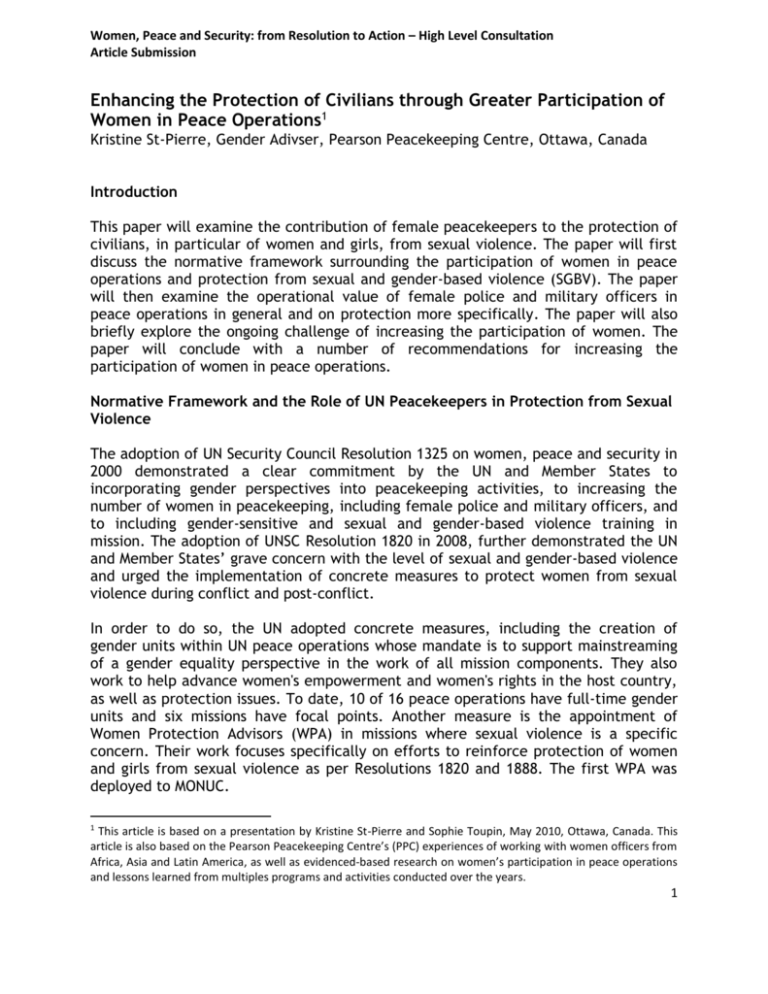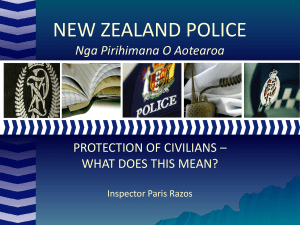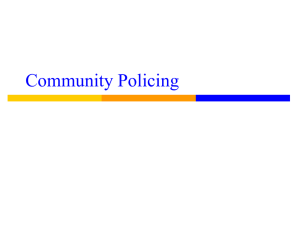
Women, Peace and Security: from Resolution to Action – High Level Consultation
Article Submission
Enhancing the Protection of Civilians through Greater Participation of
Women in Peace Operations1
Kristine St-Pierre, Gender Adivser, Pearson Peacekeeping Centre, Ottawa, Canada
Introduction
This paper will examine the contribution of female peacekeepers to the protection of
civilians, in particular of women and girls, from sexual violence. The paper will first
discuss the normative framework surrounding the participation of women in peace
operations and protection from sexual and gender-based violence (SGBV). The paper
will then examine the operational value of female police and military officers in
peace operations in general and on protection more specifically. The paper will also
briefly explore the ongoing challenge of increasing the participation of women. The
paper will conclude with a number of recommendations for increasing the
participation of women in peace operations.
Normative Framework and the Role of UN Peacekeepers in Protection from Sexual
Violence
The adoption of UN Security Council Resolution 1325 on women, peace and security in
2000 demonstrated a clear commitment by the UN and Member States to
incorporating gender perspectives into peacekeeping activities, to increasing the
number of women in peacekeeping, including female police and military officers, and
to including gender-sensitive and sexual and gender-based violence training in
mission. The adoption of UNSC Resolution 1820 in 2008, further demonstrated the UN
and Member States’ grave concern with the level of sexual and gender-based violence
and urged the implementation of concrete measures to protect women from sexual
violence during conflict and post-conflict.
In order to do so, the UN adopted concrete measures, including the creation of
gender units within UN peace operations whose mandate is to support mainstreaming
of a gender equality perspective in the work of all mission components. They also
work to help advance women's empowerment and women's rights in the host country,
as well as protection issues. To date, 10 of 16 peace operations have full-time gender
units and six missions have focal points. Another measure is the appointment of
Women Protection Advisors (WPA) in missions where sexual violence is a specific
concern. Their work focuses specifically on efforts to reinforce protection of women
and girls from sexual violence as per Resolutions 1820 and 1888. The first WPA was
deployed to MONUC.
1
This article is based on a presentation by Kristine St-Pierre and Sophie Toupin, May 2010, Ottawa, Canada. This
article is also based on the Pearson Peacekeeping Centre’s (PPC) experiences of working with women officers from
Africa, Asia and Latin America, as well as evidenced-based research on women’s participation in peace operations
and lessons learned from multiples programs and activities conducted over the years.
1
Women, Peace and Security: from Resolution to Action – High Level Consultation
Article Submission
The Resolution also called on Member States to increase the number of UN female
officers as a means of addressing sexual and gender-based violence, and to ensure
that personnel are trained to prevent, recognize and respond to incidences of sexual
violence. UN peacekeepers have a key role to play in protecting civilians from sexual
and gender-based violence, by working hand-in-hand in local communities, and
through community policing, advising and mentoring of local forces, and reporting.
Based on these roles, the next section will explore operational reasons for increasing
the presence of women in peace operations.
Operational Value of Female Peacekeepers
UN women officers bring a diverse set of skills and styles to a mission, for example,
for crowd control, investigations, community based-policing, intelligence gathering
and other police operations. In certain situations, women are often in a better
position to accomplish certain tasks, such as interviewing survivors of sexual and
gender-based violence, working in female prisons or with female prisoners, working
alongside female recruits, and relationship building with internally displaced peoples.
It has also been observed that the presence of women in peace operations can make
male peacekeepers more reflective and responsible, and can contribute to reducing
conflict and confrontation among colleagues and other personnel.2
For example, female personnel can:3
Mentor local women in the national armed forces of the host nation; For example,
Timor-Leste today has a percentage of 18% female police officers in the national
police. The UN has been present in the country since 2004 and female police
officers are being mentored by women police peacekeepers performing forensic
analysis, crowd management and crime investigations;
Act as role models to the local population and act as examples of what women in
the host community can achieve. Their deployment can have a direct impact on
the recruitment of local women to the national security forces and sets a standard
for conduct and discipline; For example, the all-female Formed Police Unit (FPU)
from India inspired Liberian women since 2007 to join the Liberian National Police.
The UN has reported a three-fold increase in the number of applications following
the deployment of the all-female FPU;
Contribute to the implementation of a security sector that is accessible to all, and
in particular to women, and that addresses their specific needs; For example,
female officers played an important role as mediators, investigators and trainers
in reconstructing police services in Liberia, Sudan, Haiti, DRC, and other
peacekeeping operations;
2
UNIFEM, 2000 Independent Experts Assessment on Women, War and Peace (2000).
See DPKO/DFS Guidelines for Integrating a Gender Perspective into the work of UN Police in Peacekeeping
Operations (2008).
3
2
Women, Peace and Security: from Resolution to Action – High Level Consultation
Article Submission
More specific to protection, the presence of female personnel can:4
Improve access and support for local women and provide a greater sense of
security to local populations (women and children);
Strengthen protection and response strategies by facilitating communication with
victims of assault, sexual abuse, violence, etc., and by help to create a safer
environment for women in which they are not afraid to talk; For example, local
women and children may be more willing to confide in female peacekeepers—
especially in cases of sexual violence. This is especially true in societies and
cultures where women are not allowed to speak with men. In addition, as men in
uniform are often the perpetrators of violence, women will be less likely to report
a crime to a man then to a women officer;
Support activities to protect women and girls; For example, in Sudan and Burundi,
sensitization sessions given by UN Police, in particular by female police officials
regarding SGBV, have led to better awareness of these acts as crimes of violence.
Tribal leaders have started opening up their understanding of these issues, which
have led to the creation of several specialised police desks that deal exclusively
with SGBV in Sudan. Such desks were set up throughout 2008-2009 at camps for
internally displaced persons (IDPs) in Southern Sudan, as part of community-based
policing.
From these examples, the operational imperative of having more women police and
military officers as part of peacekeeping missions is very clear.
Ongoing Challenge of Women Participation
Despite the operational value of women in peacekeeping, increasing the number of
women going to mission remains a challenge. As a means to strengthen the numbers,
the UN launched in August 2009 a global campaign to recruit more women in the
police and military setting targets of 20 per cent for the police and 10 per cent for
the military by 2014. While the last few years have seen a small increase in women
police officers, especially with the deployment of all-female FPUs, it has been much
more difficult on the military side. Table 1 and 2 compare the number of female
police and military officers from seven UN missions in February 2009 and March 2010
and the percentage increase.
Table 1: Number of female police officers by mission (UNPOL and FPU)
February 2009 and March 2010
4
See DPKO/DFS Guidelines for Integrating a Gender Perspective into the work of UN Military in Peacekeeping
Operations (2010), DPKO/DFS Guidelines for Integrating a Gender Perspective into the work of UN Police in
Peacekeeping Operations (2008), and UNIFEM, 2000 Independent Experts Assessment on Women, War and Peace
(2000).
3
Women, Peace and Security: from Resolution to Action – High Level Consultation
Article Submission
TOTAL: Number of Officers
Number
Officers
of
Female
Police
Percentage of Female Police
Officers
Feb. 2009
Mar. 2010
Feb. 2009
Mar. 2010
Feb. 2009
Mar. 2010
UNMIL
1201
1093
186
196
15.5%
17.9%
UNAMID
2639
4709
322
374
12.2%
7.9%
UNMIS
676
668
59
100
8.7%
14.9%
MINUSTAH
2012
2178
110
97
5.5%
4.45%
MONUC
1092
1218
57
34
5.2%
2.79%
UNMIT
1502
1520
74
68
4.9%
4.47%
ONUCI
1190
1142
21
14
1.8%
1.22%
MISSIONS
Source: Presentation by Kristine St-Pierre and Sophie Toupin, May 2010, Ottawa, Canada; data from UN
DPKO Gender Statistics.
Table 2: Number of female military officers by mission (Experts and Troops)
February 2009 and March 2010
TOTAL: Number of Officers
Number of Female Military
Officers
Percentage of Female Military
Officers
Feb. 2009
Mar. 2010
Feb. 2009
Mar. 2010
Feb. 2009
Mar. 2010
UNMIL
10,258
9,082
252
182
2.46%
2.00%
UNAMID
12,604
17,156
262
431
2.12%
2.51%
UNMIS
9,291
9,891
129
139
1.39%
1.41%
MINUSTAH
7,039
8,294
109
158
1.55%
1.90%
MONUC
17,317
19,343
269
394
1.55%
2.04%
MISSIONS
4
Women, Peace and Security: from Resolution to Action – High Level Consultation
Article Submission
UNIFIL
12542
11,506
465
463
3.71%
4.02%
ONUCI
8030
7,400
103
111
1.29%
1.50%
Source: Data from UN DPKO Gender Statistics.
From Table 1, we can observe the percentage of female police officers is more
varied, with the highest percentage being in UNMIL due to the ongoing rotation of allfemale FPUs. The percentage of female officers is also quite important in UNMIS and
UNAMID, with the later mission having the highest number of female police officers
with 374. For its part, the percentage of female military officers presented in Table 2
oscillates around 1.5 and 2 per cent, which is alarmingly low considering the
challenges that these complex missions are facing. It is also interesting to note the
low percentage of female military and police officers in MONUC with 2 per cent
female military and 2.79 per cent female police officers. These are worrying
statistics, especially given the level of sexual and gender-based violence in the DRC
and the challenges brought about by such crimes.
Conclusion
As women often represent more than half the adult population of a given society, it
makes sense that a peace operation should reflect, to the extent possible, the gender
demographic of the country in which it is deployed. Of equal importance, however, is
the need to recognize the operational value that women police and military personnel
bring to peacekeeping. Greater participation of women in peace operations is not only
a normative requirement, but an operational one, and deploying a higher percentage
of women military and police peacekeepers will not only help to achieve gender
equality in UN peace operations, but will also have a positive impact on the
effectiveness of the missions themselves.
In conclusion, the paper offers three recommendations for increasing the
representation of women in peace operations:
1) National police and military services should ensure adequate policies and
processes are in place to ensure equitable access and treatment for women in
their services;
2) Troop and police contributing countries and the UN should work hand-in-hand
to ensure that all personnel have the necessary tools and the skills to carry out
and enforce their mandate; and
3) Peacekeeping missions should ensure training and support structures are in
place to guarantee that women are given equal opportunities to participate as
agents of change.
5






